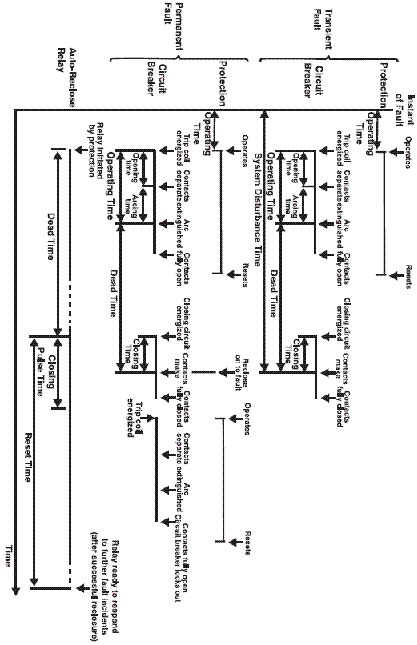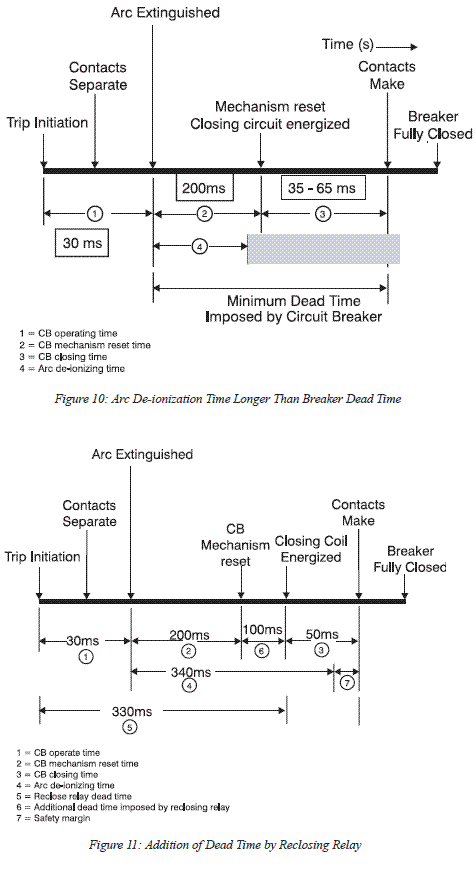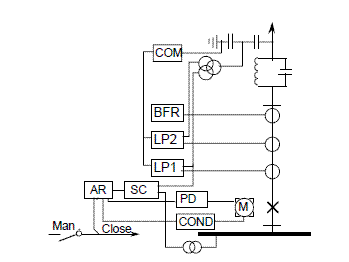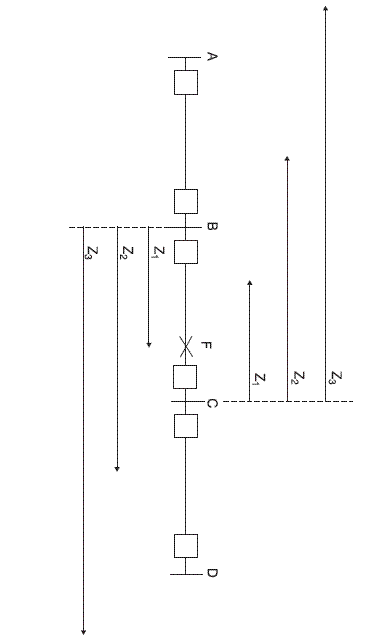- This topic has 3 replies, 1 voice, and was last updated 2 years, 11 months ago by
حمید.
-
CreatorTopic
-
2021-08-03 at 11:08 am #739
مرتضی
برای ستینگ ریکلوزر پارامترهای مختلفی وجود دارد برای تنظیم دقیق چه باید کرد؟و pick up به چه منظور است؟
برای ستینگ ریکلوزر پارامترهای مختلفی وجود دارد برای تنظیم دقیق چه باید کرد؟و pick up به چه منظور است؟ -
CreatorTopic
-
AuthorReplies
-
2021-08-03 at 11:08 am #2550
گلاویژ
در آتو ریکلوزر سه فاز زمان قطع بریکر 300 میلی ثانیه ولی در تک فاز 800 میلی ثانیه است ( زیرا در سه فاز ، فازها مجاز نیستند از هم دور شوند ولی در تک فاز خطیر بودن مساله تا این حد نیست و زمان قطعی بریکر تا 800 میلی ثانیه هم مجاز است ) . مساله دیگر تعداد وصل مجدد یا single shot or double shot است که بسته به وضعیت خط دارد . پارامتر دیگری هست به نام reclaim time که معمولاً آن را روی 60 ثانیه ست می کنند . اگر آتوریکلوزر ظرف 60 ثانیه سه بار فالت را حس کرد نتیجه می گیرد خط ، خط پر حادثه ای است و عملکرد آتوریکلوزر را قفل می کند
2021-08-03 at 11:08 am #2552گلاویژ
عذر می خواهم به سؤال شما در مورد pick up جواب ندادم . تا سطح 20 کیلو ولت خود آتو ریکلوزر و بریکر و وسیله ی حفاظتی می تواند درون یک پکیج باشد . ولی از سطح 20 کیلو ولت به بالا آتور ریکلوز تجهیزی است مستقل که ورودی را از سیتم حفاظتی می گیرد و فرمان را به بریکر می دهد . در واقع pick up خود تنظیم رله یا وسیله ی حفاظتی overcurrent است .البته مدیر سایت قطعاً توضیحات جامع تری دارند
2021-08-03 at 11:08 am #2555حمید
تعاریف و اصطلاحات در گیر با اسکیم اتو ریکلوزر به شرح زیر قابل بیان است.
-Arcing time (of a mechanical switching device) The interval of time between the instant of the first initiation of the arc and the instant of final arc extinction in all poles. -Breaker reclosing time The elapsed time between the energizing of the breaker trip coil and the closing of the breaker contacts to reestablish the circuit by the breaker primary contacts on the reclose stroke. (i.e., breaker operating time plus breaker dead time). -Closing time (of a mechanical switching device) The interval of time between the initiation of the closing operation and the instant when metallic continuity is established in all poles. -Dead time (of a circuit breaker on a reclosing operation) The interval between interruption in all poles on the opening stroke and reestablishment of the circuit on the reclosing stroke. Note: The dead time of an arcing fault on a reclosing operation is not necessarily the same as the dead time of the circuit breakers involved, since the dead time of the fault is the interval during which the faulted line is de-energized from all terminals. -De-ionizing time The time following the extinction of an overhead line fault arc necessary to ensure dispersion of ionized air so that the arc will not re-strike when the line is re-energized. -Delayed autoreclosing The autoreclosing of a circuit breaker after a time delay that is intentionally longer than for high-speed autoreclosing. -High-speed autoreclosing The autoreclosing of a circuit breaker after a necessary time delay (typically less than one second) to permit fault arc de-ionization with due regard to coordination with all relay protective systems. This type of autoreclosing is generally not supervised by voltage magnitude or phase angle. -Operating time (circuit breaker) The time from the energizing of the trip coil until the fault arc is extinguished. Operating time (protection) The time from the inception of the fault to the closing of the tripping contacts. Where a separate auxiliary tripping relay is employed, its operating time is included. -Reset time (of an automatic circuit recloser or automatic line sectionalizer) The time required, after one or more counting operations, for the counting mechanism to return to the starting position. -System disturbance time The time between the inception of the fault and the circuit breaker contacts making on successful reclosing. -Single-shot reclosing An operation sequence providing only one reclosing operation, lockout of the circuit occurring on subsequent tripping.  Choice of Dead Time The dead time setting on a high-speed autoreclosing relay used on transmission lines should be long enough to allow complete arc de-ionization. When using high-speed reclosing with modern fast circuit breakers, it is important to know that at some point the de-ionization time requirement will be longer than the dead time imposed by the circuit breaker. (See Figure 10.) Times shown are typical for high-speed HV breakers. Arc deionizing time is shown as variable and depends primarily on the voltage level. At the point where arc-deionizing time is longer than the dead time imposed by the circuit breaker, dead time must be introduced outside of the breaker. This is done with a dead time or reclose time setting in the autoreclosing relay. (See Figure 11.)
Choice of Dead Time The dead time setting on a high-speed autoreclosing relay used on transmission lines should be long enough to allow complete arc de-ionization. When using high-speed reclosing with modern fast circuit breakers, it is important to know that at some point the de-ionization time requirement will be longer than the dead time imposed by the circuit breaker. (See Figure 10.) Times shown are typical for high-speed HV breakers. Arc deionizing time is shown as variable and depends primarily on the voltage level. At the point where arc-deionizing time is longer than the dead time imposed by the circuit breaker, dead time must be introduced outside of the breaker. This is done with a dead time or reclose time setting in the autoreclosing relay. (See Figure 11.)  Choice of Reset Time The reset time of autoreclosing relays on transmission lines must be long enough to allow the protective relays to operate when reclosing onto a permanent fault. Times from 3 to 10 seconds are common. Also, note that the reset time of the protective relay should be short enough so it is completely reset prior to the circuit breaker closing on a reclose operation. In this way, the protective relay will be prepared to operate if the reclose operation is not successful.
Choice of Reset Time The reset time of autoreclosing relays on transmission lines must be long enough to allow the protective relays to operate when reclosing onto a permanent fault. Times from 3 to 10 seconds are common. Also, note that the reset time of the protective relay should be short enough so it is completely reset prior to the circuit breaker closing on a reclose operation. In this way, the protective relay will be prepared to operate if the reclose operation is not successful.  Number of Reclose Attempts High-speed reclosing on transmission and subtransmission systems where stability is a concern is invariably single shot. Repeated attempts of reclosing with high fault levels would have serious effects on system stability. Furthermore, the incidence of semi-permanent faults that could be cleared by repeated reclosures is to be less likely than on distribution systems. The Auto reclosing shall be coordinated with various equipment as indicated in Figure below.
Number of Reclose Attempts High-speed reclosing on transmission and subtransmission systems where stability is a concern is invariably single shot. Repeated attempts of reclosing with high fault levels would have serious effects on system stability. Furthermore, the incidence of semi-permanent faults that could be cleared by repeated reclosures is to be less likely than on distribution systems. The Auto reclosing shall be coordinated with various equipment as indicated in Figure below.  AR – Auto-recloser BFR – Breaker failure relay COM – Communication COND – CB condition DLC SC – Dead line check and synchronism check LP – Line protection MAN – Manual CB control PD – Pole discordance relay When using step distance relaying on lines with high-speed reclosing, attempting to perform simultaneous tripping presents some difficulties. Because of the errors involved in determining the ohmic setting of distance relays, it is difficult, if not impossible, to accurately set a distance relay to cover 100% of the line with high-speed relaying. It is common to allow for these errors by setting the relay to cover 80-90% of the line length in the first or instantaneous zone. Figure 13 illustrates a typical three-zone distance scheme covering two transmission lines. Thus, there is a zone near the end of each line in which the faults are cleared by sequential tripping. These end zones represent 20-40% of the line length. The remaining 60-80% between the end zones is cleared simultaneously by the breakers at both ends. Therefore, a fault occurring in an end zone would be cleared in the zone 1 time, or instantaneously, by the protection at one end of the line, and in the zone 2 time (0.3-0.4 seconds) by the protection at the other end. High-speed reclosing used on the circuit breakers at each end of the line could result in a dead time insufficient to allow for de-ionization of the fault arc. A transient fault could, therefore, be reclosed on and seen as a permanent fault, resulting in the locking out of both breakers. There are two methods available for overcoming this problem. The first, where there is no pilot channel, is an extension of the zone 1 reach to apply instantaneous tripping over the entire line. The second is the use of a signaling channel to send a tripping signal to the remote end when a local zone 1 trip occurs.
AR – Auto-recloser BFR – Breaker failure relay COM – Communication COND – CB condition DLC SC – Dead line check and synchronism check LP – Line protection MAN – Manual CB control PD – Pole discordance relay When using step distance relaying on lines with high-speed reclosing, attempting to perform simultaneous tripping presents some difficulties. Because of the errors involved in determining the ohmic setting of distance relays, it is difficult, if not impossible, to accurately set a distance relay to cover 100% of the line with high-speed relaying. It is common to allow for these errors by setting the relay to cover 80-90% of the line length in the first or instantaneous zone. Figure 13 illustrates a typical three-zone distance scheme covering two transmission lines. Thus, there is a zone near the end of each line in which the faults are cleared by sequential tripping. These end zones represent 20-40% of the line length. The remaining 60-80% between the end zones is cleared simultaneously by the breakers at both ends. Therefore, a fault occurring in an end zone would be cleared in the zone 1 time, or instantaneously, by the protection at one end of the line, and in the zone 2 time (0.3-0.4 seconds) by the protection at the other end. High-speed reclosing used on the circuit breakers at each end of the line could result in a dead time insufficient to allow for de-ionization of the fault arc. A transient fault could, therefore, be reclosed on and seen as a permanent fault, resulting in the locking out of both breakers. There are two methods available for overcoming this problem. The first, where there is no pilot channel, is an extension of the zone 1 reach to apply instantaneous tripping over the entire line. The second is the use of a signaling channel to send a tripping signal to the remote end when a local zone 1 trip occurs. 
-
AuthorReplies
- You must be logged in to reply to this topic.
